Preserving Biodiversity
Making use of Musashino Forest remaining on the premises of Tokyo Factory Biodiversity preservation initiatives
The Fuji Electric Tokyo Factory is located five minutes’ walk from Toyoda Station on the JR Chuo Line. On the premises, there is one green tract of land that is clearly different from the development around the factory. Fuji Electric has named this green space Musashino Forest, and is working to preserve its biodiversity by maintaining it in cooperation with local residents.
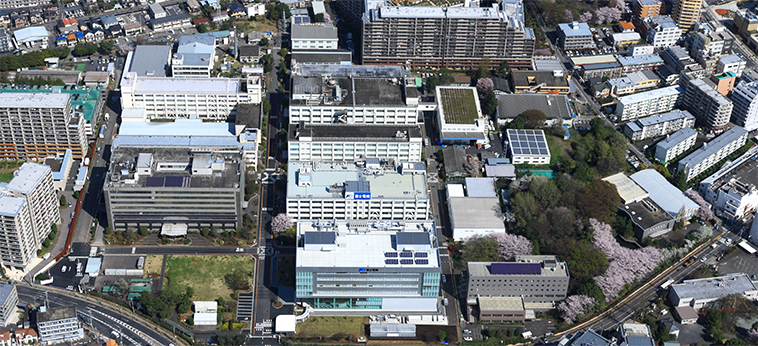
Forest left untouched for more than 70 years since the factory’s establishment
Just inside the east gate of the Tokyo Factory, behind the office building, is a thick forest of tall trees. It is unusual to find such a large green space in the Tokyo metropolitan area, especially in a business establishment close to a train station.
Makoto Chigira, Chief of the General Affairs Section, General Affairs Department, Tokyo Factory, explains the reason why:
“Tokyo Factory was established in 1943, during World War II. The factory in the former Keihin Industrial Zone was evacuated because it was said to be a likely target for air raids. In those days, there were only a few houses in front of Toyoda Station, and the area was full of greenery and rich in nature. After the war, the surrounding area was developed for housing, but the green space on the premises has been left as it was in the past.
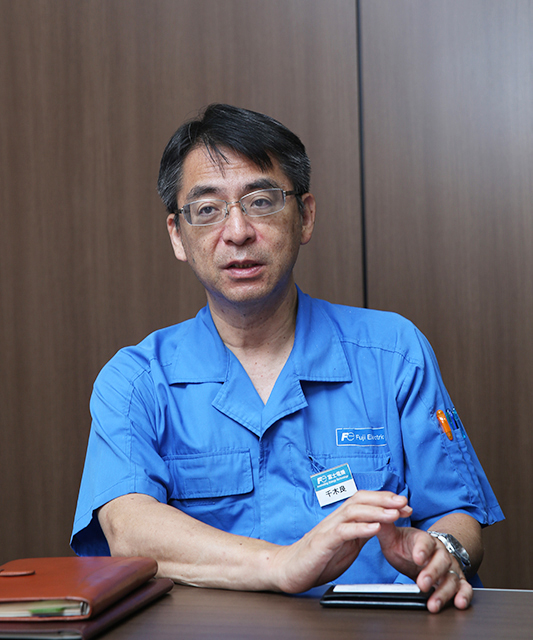
Makoto Chigira, General Affairs Section, General Affairs Department
The factory is located in Hino City, and the city’s population and the number of employees at the factory have increased almost proportionally. The factory developed along with the community, but even as greenery disappeared from the surrounding area, it remained on the factory’s premises, like an air pocket.
Chigira describes the richness of the forest:
“There are many wild birds, such as Japanese tits and rufous turtle doves. Bamboo shoots also come out in the spring, and some employees come to pick them. (Laughs.) And the local community has also requested that we share the bamboo grass for the Tanabata Star Festival.
Biodiversity preservation gathering momentum
Fuji Electric takes advantage of this rich natural environment to carry out biodiversity preservation activities.
Now, what exactly is biodiversity?
The Earth has a biosphere, which is formed by many living things that engage in vital activities and interacting in their respective places, creating ecosystems. It takes a variety of living things to stabilize an ecosystem and sustain the environment. However, the expansion of human activities has led to the extinction of many species, and we are facing a crisis in which diversity may be lost.
In 1992, the Convention on Biological Diversity was concluded by 190 countries, including Japan and the European Commission, at the United Nations Conference on Environment and Development (the Earth Summit). In 2010, the 10th Conference of the Parties to the Convention on Biological Diversity was held in Nagoya. With such increasing momentum for preserving biodiversity, Fuji Electric formulated its Biodiversity Action Guidelines in March 2010 and has been working to achieve these goals since.
Minimal maintenance while preserving the present condition
So how did the maintenance of Musashino Forest start?
Masahiko Masuda, Chief of the Environmental and Facilities Section, General Affairs Department, Tokyo Factory, explains:
“Fuji Electric has long been working on the environmental ISO. We were motivated by an ISO examiner, who recommended that we work on biodiversity preservation by taking advantage of the large, conserved green space. And the Tokyo Factory already had a good foothold in working together with the community to tackle various natural environment issues.”
It had previously cooperated with environmental groups such as the Takao Forestation Association and the Association for the Protection of Nature in Hino.” Many Fuji Electric employees participate in these groups, and even after retirement, a considerable number become members so they can continue their activities.
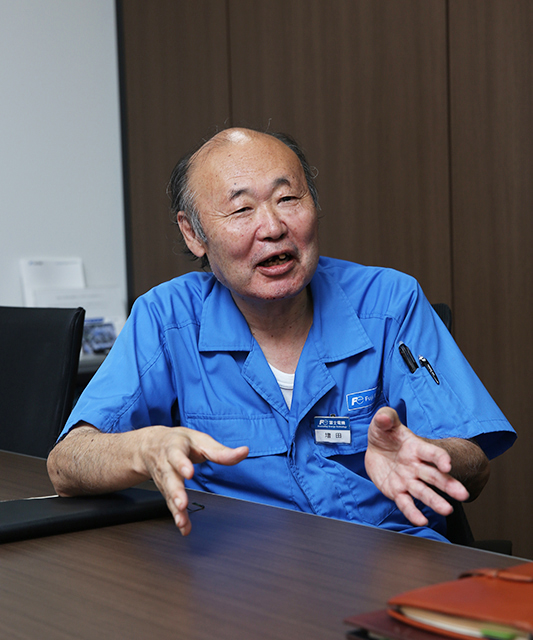
Masahiko Masuda, Environmental and Facilities Section, General Affairs Department
With environmental activities ongoing, in 2008, there was an internal suggestion to make use of Musashino Forest. Full-scale efforts began in 2015. In connection with Hino City’s Formulation of Regional Biodiversity Strategy, discussed over a three-year period from 2015, it was decided that we should also value the relationship with the neighboring Kurokawa Seiryu Park, Tamadaira Forest, and Asakawa River, and maintain Musashino Forest as well.”
In this way, they moved forward preparations while consulting the Environmental Coexistence Department of Hino City. They invited people from the Wild Bird Society of Japan to visit the Forest, who were surprised to find many wild birds.
“We have also set up birdhouses made by members of the Takao Forestation Association. We think that it’s meaningful to work with local people in this way. Listening to experts is also important.
They unanimously said that it was wonderful to have a forest remaining untouched like this. For that reason, we decided to perform the minimum level of maintenance while preserving the present condition as much as possible.”
Taking on a new task from scratch
It is true that, to preserve nature, the forest should be left untouched. However, in order to carry out activities based on one of our action guidelines, “Work with Society to Actively Promote Biodiversity Action,” we need human intervention to make use of the natural environment, which is valuable, and to convey the importance of biodiversity. The point is to allow people to interact with nature while performing minimum maintenance.
Specifically, we built a promenade and provided tables and chairs. We also planted hydrangea bushes, including 100 donated by the Tourism Division of the Tokyo Metropolitan Government and 30 purchased by the company.
This maintenance work was handled by the staff of Fuji Electric Frontier Co., Ltd., a special-purpose subsidiary established in 1994 for the purpose of promoting the employment of people with disabilities. The company handles cleaning and mail collection/delivery within the Group companies.
Makoto Kadowaki, Chief of the Operation Section of the company's Tokyo Office, shares with a wry smile the confusion he felt at the start of this work.
“Before then, the only thing I knew about plants was taking care of flower beds. It was a big task that I had no experience with, and I didn’t know what to do. I was assigned to develop the place where fallen leaves were collected to make mulch. I had absolutely no idea what was the first step to build a promenade there. I consulted with the Environmental and Facilities Section to move forward with the task."
The most difficult part was disposing of the kuma bamboo grass, which was very thick. To build a promenade, we first needed to cut down this grass. Once the ground was cleared, we laid down weed control sheets, installed partition boards on both sides, and spread woodchips to make it easy to walk.
“Kuma bamboo grass is very fertile, so unless the roots were properly eliminated, it would grow right through the weed control sheets."
Tomoya Yauchi, who was in charge of the work, comments:
“We had to work in summer and it was unbearably hot. I got a lot of mosquito bites, too. (Laughs.) But in the course of work, I found beetle larvae and other things that made me feel close to nature. We all came together and literally sweated to maintain Musashino Forest, so I want many people to see it.”
One suggestion we’ve had is to give beetle larvae to children at the factory summer festival, to which local residents are invited every summer.
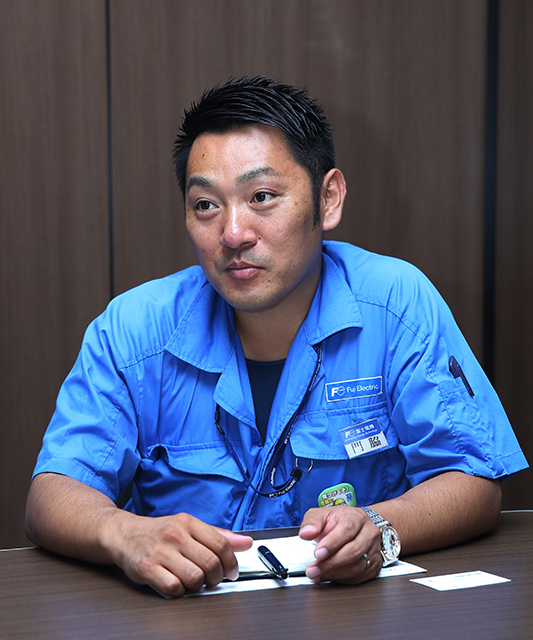
Makoto Kadowaki, Fuji Electric Frontier
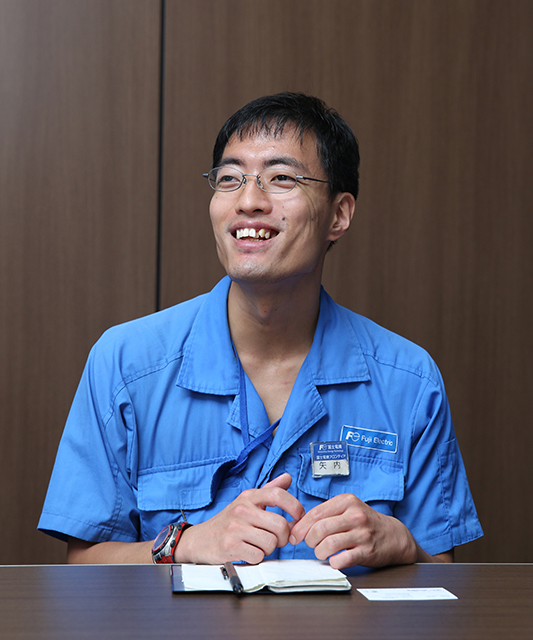
Tomoya Yauchi, Fuji Electric Frontier
Aiming to create a place that can heal the hearts of many
Returning to Chigira:
“At present, only a small part of Musashino Forest is being maintained. We will continue to maintain this area while considering how we can attract birds, butterflies, and other living creatures. We will also make it a preservation area for rare species and create a relaxing spot for employees and local residents.”
He also wants to deepen people’s understanding of biodiversity.
“In the future, we are considering opening the forest to the public. But there are also dangers because it is on the factory premises. For the time being, we will invite local people to see it during the summer festival. We are also considering having experts give lectures on biodiversity at such events.” Certainly, people would come away with a much different impression of the forest depending on if they just happened to see it, or if they looked at it with knowledge of biodiversity.
We intend to continue to expand the area of Musashino Forest that we maintain and to promote biodiversity preservation in cooperation with society.
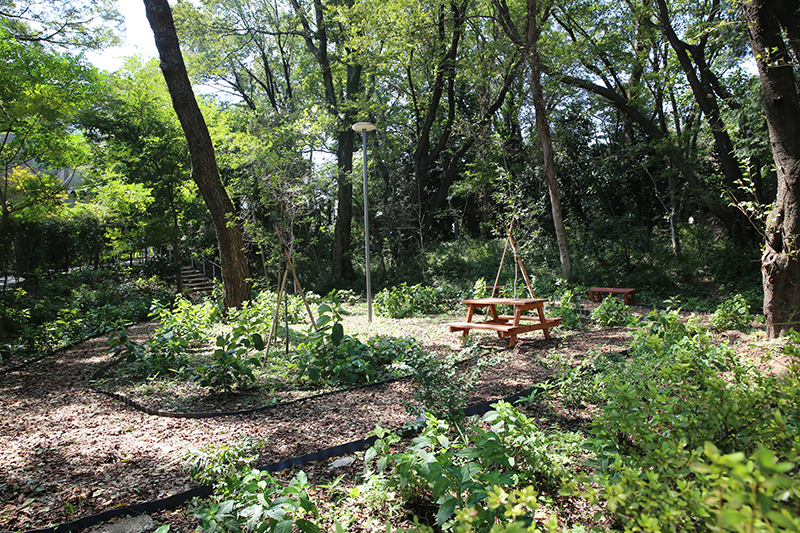
Recreation area with a promenade and woodchips
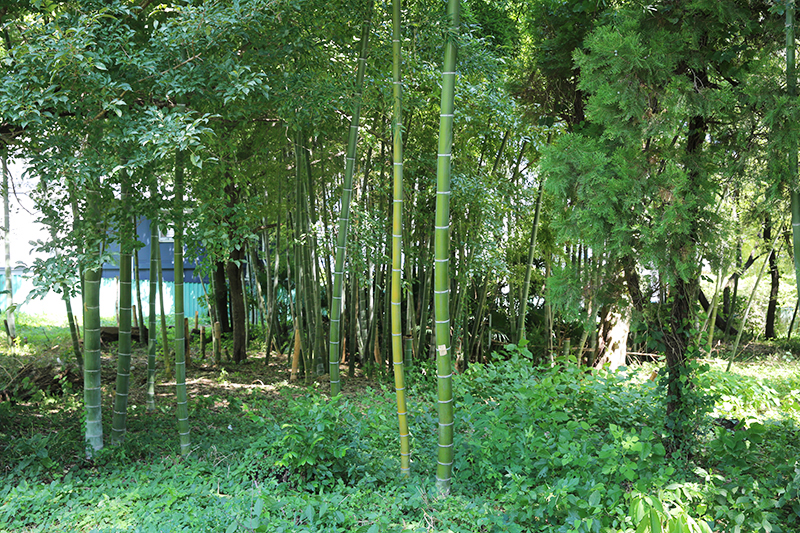
Bamboo grove expanding along the path on the premises


